Of course, a huge range of offered devices in almost all segments of consumer electronics is very convenient for the consumer. Unfortunately, this abundance also complicates the choice. But even a cursory analysis of the specs often makes the task easier. Alas, the lack of unification significantly complicates the process, and advertising does not always objectively characterize the real capabilities of the model.
High-tech projectors have not escaped this problem either. Their main specs include dimensions, weight, noice, brightness, contrast, resolution, adjustments, audio, connectivity and rechargeable batteries.
For marketing reasons, some companies often position projectors with solid light source (LEDs or laser LEDs) weighing a few pounds as mini or pico. This was hardly correct in relation to consumers, because most of these projectors are unlikely to fit even in a sufficiently large pocket.
Lamp models are always large in size and weight due to the need to dissipate the heat of the lamp using a sufficiently powerful fan. In addition, the operation of a powerful fan is accompanied by a fairly high noise level up to 40 dB and even higher.
Brightness
Of course, brightness is one of the main specs of any projector, providing contrast and clarity to bright areas of an image. As known, a low-brightness model projects too dim image. But screen size also affects illumination.
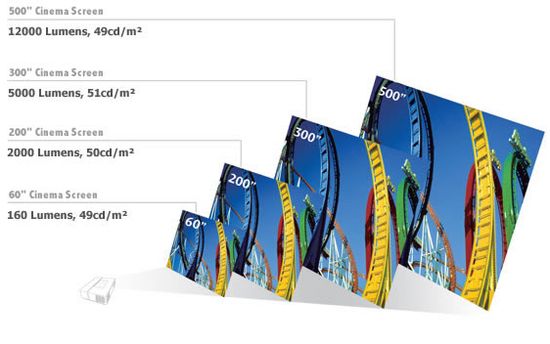
In particular, its increasing reduces the luminous flux density per unit of image area. Therefore, perceived illumination depends on the projector brightness and the image size.
Specified screen size in spec, for example, from 30 to 200 inches, characterizes mainly the capabilities of the optics in terms of projecting a focused image. But in daylight, a low brightness model will only be able to provide a reasonably saturated image on screens up to 70″ or less. High brightness provides high image quality even on a large screen and reduces room dimming requirements. For example, a Home Theater without daylight requires up to 1,000 ANSI lm even for large projection. But viewing outdoors or in the living room increases the brightness requirements to several thousand ANSI lm for screens 100″ and up.
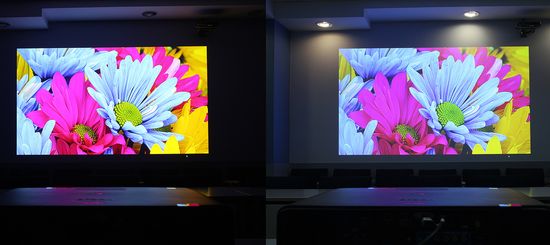
A few years ago, low brightness was a major problem with LED projectors. Today companies have successfully solved it with powerful modern LEDs, which providу 1,000 ANSI lm and up.
But this aspect has a nuance. Some companies indicate the illumination of the screen in Lux instead of the more traditional projector brightness in ANSI lm. Maybe this is logical, because perceived illumination is more important to the consumer. Unfortunately, they usually do not indicate the screen size for this value. Simplified, 1 ANSI lm provides 1 Lux on a 1m² screen. Accordingly, 1 ANSI lm = 1 Lux for 57 inches diagonal, and 3.2 Lux for 100 inches diagonal.
Color Light Output (CLO)
In addition, companies have long debated methods for measuring brightness.
The single-chip DLP and three-chip 3LCD projectors form the image differently. In particular, 3LCD technology uses light with virtually no loss.
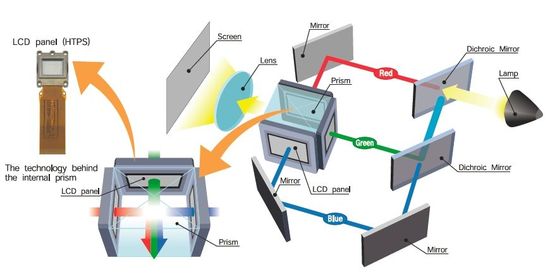
In these models, light falls on mirrors, which transmit light of a certain frequency (color), while reflecting the rest. As a result, two mirrors divide the white light stream into red, green and blue RGB components. Each of them is directed to the corresponding monochrome LCD matrix. The matrices form at the output black-red, black-green and black-blue images. The prism combines them into a full color image and sends to the optical system. Of course, in this case, the projector provides the same white and color brightness.
DLP (Digital Light Processing) projector uses DMD (digital micromirror device) and a color wheel.
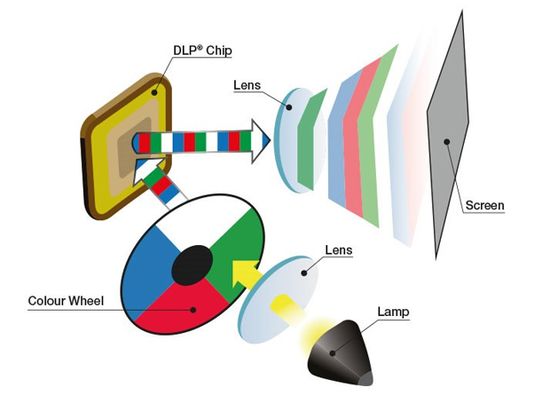
A DLP projector generates only one color at a time, losing two others on the color wheel. Of course, the developers partially compensate for the brightness loss with a white filter. But increasing the ANSI lumens number does not affect CLO, increasing the difference between them. Therefore, even with the same white brightness, 3LCD and DLP projectors provide different color brightness.
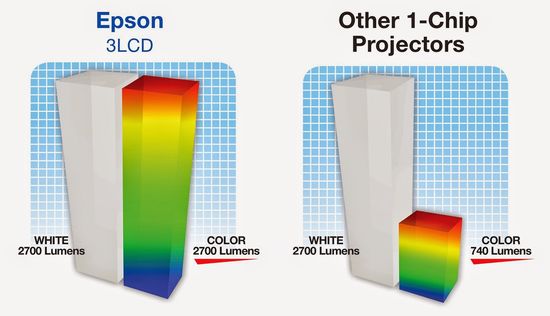
Of course, this factor affects the colors saturation.

Brightness measurement methods
Different technologies have led to the development of two different methods for measuring brightness. ANSI lumens are measured with 100% white test pattern only for the white brightness. The CLO method measures red, green and blue using test patterns and adds the results together.
As known, 3LCD technology was developed by Epson, which today dominates the 3LCD segment. For obvious reasons, the company disagrees with the ANSI lumens’ methodology for assessing brightness, insisting on measuring Color Light Output (CLO).
But this debate has additional aspects due to the compelling arguments of Epson’s opponents. In particular, the CLO measurement does not take into account color accuracy. The highest ANSI lumen and CLO ratings out of a 3LCD projector require full opening of all chips. As a consequence, the very common green shift from the light source adds a green tint to white, upsetting the color balance.

But the green shift calibration is accompanied by a decrease in the brightness of the 3LCD projector. DLP projectors typically compensate for this with a red filter for purer whites.
Thus, today ANSI lumen and CLO specs have limitations in terms of colors brightness and color accuracy.
Some companies indicate the screen illumination in Lux. But in this case, estimating the actual projector brightness requires taking into account the screen size (1 ANSI lm provides 1 Lux on a 1m² screen.)
Maybe the companies will create a unified spec. In theory, it should objectively characterize the projector in terms of perceived image brightness (screen illumination) and its realism (color accuracy).
LED ANSI lm
Some companies indicate the brightness of their LED projectors as LED Lm. This situation arose due to a discussion between experts about the influence of Helmholtz – Kohlrausch effect on perceived brightness. According to this version, the eye perceives the brightness of individual colors as the overall brightness. As known, LEDs provide significantly higher colors brightness.
Therefore, the perceived brightness of image from LED projector is significantly higher compared to lamp projectors with similar brightness in ANSI Lm. Comparison photos from ViewSonic perfectly illustrate this effect.
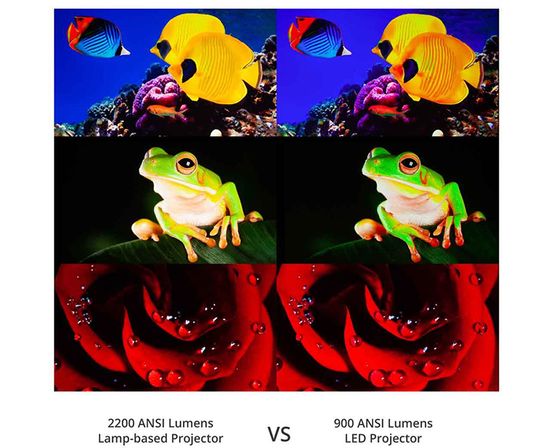
Contrast, resolution, adjustments and other
Contrast characterizes the ratio of white to black, and affects color accuracy and image clarity in bright areas of the frame. A contrast ratio from 2,000: 1 and higher is quite sufficient for budget segment. Более дорогие модели обычно обеспечивают 3,000: 1 and higher.
For marketing purposes, manufacturers often specify dynamic contrast that is fundamentally different from native contrast. It can reach hundreds of thousands with dynamic iris in expensive models.
The modern market offers projectors with a resolution of 240p, 480p, 720p, 1080p, 4K Ultra HD and even 8K. Budget models for movie viewing usually provide native 720p with 1080p support. But, of course, they do not display 1080p. This model only takes this content and, after downscaling, plays back native 720p.
Keystone adjustment is one of the more popular adjust.

It reduces the requirements for strictly perpendicular installation of the projector to the screen (90 degrees between the optical axis and the plane of the screen). Atomatic keystone adjustment is just a button push. But manual adjustment by adjusting wheel is also very simple.
Many models have built-in mid-range speakers and Bluetooth or AV connector for external speakers.
Connectivity is very important for accessing content. Most modern models connect to a smartphone and support screen-mirroring options. As known, wireless Screen Mirroring technology provides transferring content from Android, Windows or Apple devices to a TV or projector using the Miracast protocol.
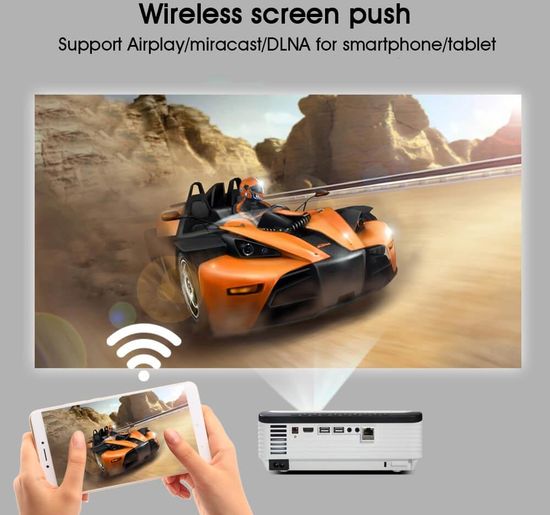
In addition, modern mini models often have a built-in battery, which adds weight, but is very convenient when viewing outdoors. They usually provide several hours of battery life.
The maximum screen size is limited only by the focusing capabilities of the optics and often reaches several hundred inches.
Conclusion
Due to the uncertainty of the calculation methods, the brightness in the specs requires indirect confirmation. It directly affects color saturation, color accuracy and image quality depending on the image size and ambient lighting. In theory, 2,000 ANSI lm or 1,000 CLO or 4,000 Lux should provide reasonably high quality. But usually the opinion of users about a particular model more closely matches the real capabilities of the projector. Other specs do not have such problems.
The video shows the basic pros & cons DLP vs LCD projectors.
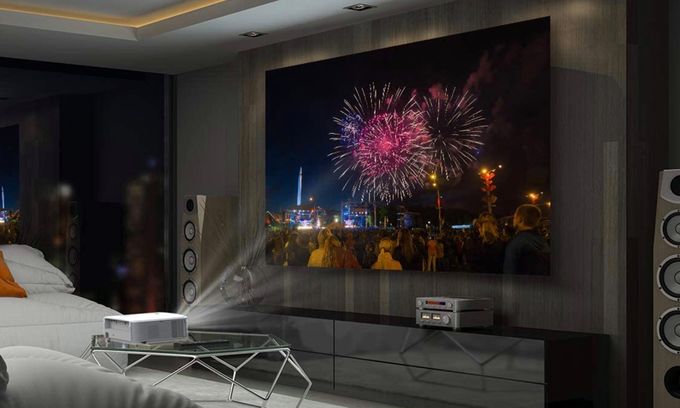
Pingback: Newest AuKing and Jinhoo projectors Review - The Appliances Reviews
Pingback: Newest mini projectors Review - The Appliances Reviews
Pingback: Epson EpiqVision LS500 UST laser projector instead of a TV? - The Appliances Reviews
Pingback: Epson EpiqVision LS300 UST projector Review - The Appliances Reviews
Pingback: Living room projector vs TV Review - The Appliances Reviews